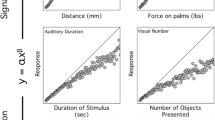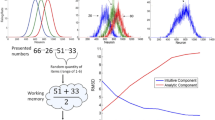Abstract
The responses of “complex” simple cells to sharp and blurred ramp edges were studied. These responses are quite similar to those in the case of lines, which implies that phase information cannot be used to discriminate between ramp edges and lines. Furthermore, if the maximum of the modulus is used as a position estimate, a systematic bias toward the ramp side results, and this bias increases with edge blur. In contrast, a local extremum in the real part of the cell responses provides a precise position estimate, even for strongly blurred edges. Possible multiscale detection strategies are discussed in the context of a syntactical visual reconstruction. This is illustrated by an explanation of Mach bands as perceived at trapezoidal edges, including Ratliffs Mach-band cancellation stimulus, and criteria for local probability summation in the prediction of Mach-band detection thresholds are presented.
Similar content being viewed by others
References
Békésy G von (1968) Mach- and Hering-type lateral inhibition in vision. Vision Res 8:1483–1499
Bischof WF, Caelli T (1988) Parsing scale-space and spatial stability analysis. Comput Vision Graphics Image Process 42:192–205
Blake A (1985) Boundary conditions for lightness computation in Mondriaan world. Comput Vision Graphics Image Process 32:314–327
Blommaert FJJ, Martens JB (1990) An object-oriented model for brightness perception. Spatial Vision 5:15–41
Buf JMH du (1992a) Modelling spatial vision at the threshold level. Spatial Vision 6:25–60
Buf JMH du (1992b) Brightness versus apparent contrast 1: incremental and decremental disks with varying diameter. Spatial Vision 6:159–182
Buf JMH du (1992c) Lowpass channels and White's effect. 15th European Conference on Visual Perception, Pisa, Perception 21:A80
Buf JMH du (1993a) Responses of simple cells:events, interferences, and ambiguities. Biol Cybern 68:321–333
Buf JMH du (1993b) Ambiguities in Gabor space. In:Gale AG (eds) Visual Search III, Taylor and Francis, London (in press)
Field DJ, Hayes A, Hess RF (1993) Contour integration by the human visual system:evidence for a local “association field”. Vision Res 33:173–193
Fiorentini A, Radici T (1958) Brightness, width and position of Mach bands as a function of the rate of variation of the luminance gradient. Atti Fond Giorgio Ronchi 14:145–155
Kingdom F, Moulden B (1992) A multi-channel approach to brightness coding. Vision Res 32:1565–1582
Lowry EM, DePalma JJ (1961) Sine-wave response of the visual system. I. The Mach phenomenon. J Opt Soc Am 51:740–746
Marčelja S (1980) Mathematical description of the responses of simple cortical cells. J Opt Soc Am 70:1297–1300
McCollough C (1955) The variation in width and position of Mach bands as a function of luminance. J Exp Psychol 49:141–152
Ratliff F (1984) Why Mach bands are not seen at the edges of a step. Vision Res 24:163–165
Ross J, Morrone MC, Burr DC (1989) The conditions under which ach bands are visible. Vision Res 29:699–715
Schouten G (1993) Luminance-brightness mapping:the missing decades. Thesis, Eindhoven Technical University, The Netherlands
Venkatesh S, Owens R (1990) On the classification of image features. Pattern Recognition Lett 11:339–349
Author information
Authors and Affiliations
Rights and permissions
About this article
Cite this article
du Buf, J.M.H. Ramp edges, Mach bands, and the functional significance of the simple cell assembly. Biol. Cybern. 70, 449–461 (1994). https://doi.org/10.1007/BF00203238
Received:
Accepted:
Issue Date:
DOI: https://doi.org/10.1007/BF00203238




